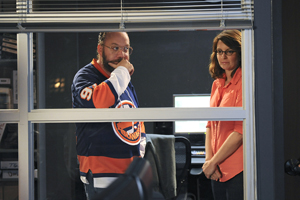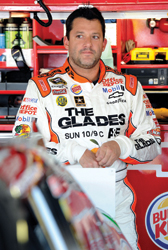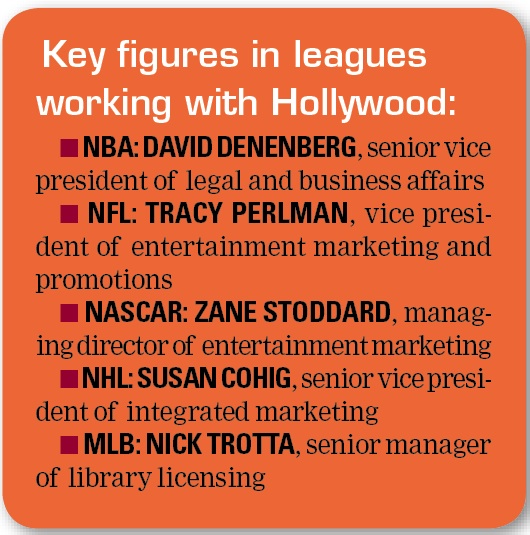Twenty years ago, a young executive producer named Barry Josephson worked on a movie called “The Last Boy Scout.” In that movie, starring Bruce Willis and Damon Wayans, one of the characters is a football player who, armed with a gun, shoots three defenders as he carries the ball into the end zone — and then takes his own life.
Contrast that with Josephson’s role as executive producer on the Fox TV drama “Bones,” where one of the lead characters, FBI agent Seeley Booth, has a Philadelphia Flyers bobblehead and a replica Stanley Cup on his desk, along with framed hockey pictures on his walls.
In one memorable episode, Booth, played by David Boreanaz, gets knocked unconscious and plays a game of one-on-one hockey with retired left wing Luc Robitaille as part of a dream sequence.
 |
NBC
The NHL’s relationship with the producers of NBC’s “30 Rock” has made team gear a common sight on the comedy series. |
The NHL helped line up Robitaille’s cameo and regularly assists Josephson with props and anything else the producer needs to keep hockey as part of Booth’s persona. As for “The Last Boy Scout,” it should come as no surprise that the NFL had no role in a movie that included scenes of players being murdered on a football field.
“When your subject matter is very positive for a league, or a script doesn’t have anything controversial in it, then it’s very easy to work with a league,” said Josephson, whose next sports-related project is a family film about a boy encountering the ghosts of Lou Gehrig and other legendary New York Yankees. “When you do a movie or a television show where the subject matter isn’t exactly something they approve of, you will get turned down.”
Leagues and franchises routinely hear pitches to bring the verisimilitude of sports-related themes, props and, as the Robitaille example shows, even the occasional cameo, to movies and TV shows.
Each of the major leagues has at least one, if not several, executives working on vetting and making pitches to be included in shows and movies. Key motivators for the leagues include the chance to reach a mass audience, win favor among prospective new fans, and earn pop-culture cachet.
On the other side, actors, producers, writers and directors believe sports teams can establish a scene or character, lend authenticity and liven things up, particularly through a scene involving a familiar player or stadium.
Bringing the two sides together still requires negotiation. Having a game on as part of the background in a scene or putting a character in a team T-shirt or jersey usually involves a league’s licensing, creative and production groups, while scenes involving shooting on location at a team venue or with an extensive theme of a particular sport require even more approvals and involvement.
With the exception of NASCAR, all of the leagues spend the bulk of their time responding to entertainment queries rather than making many pitches of their own.
Zane Stoddard, NASCAR managing director of entertainment marketing, said only 5 percent of the integrated projects involving the racing league come from requests by studios and producers. NASCAR generates the rest, with Stoddard working from the league’s Los Angeles entertainment office to foster interest among entertainment executives, directors, writers and producers (he held a similar position at the NBA; the league later closed its entertainment office in California).
“The entertainment community is very receptive to working with NASCAR, but most of that transpires from proactively
contacting them,” Stoddard said.
Recent and upcoming examples include a racing-themed episode of ABC’s “Charlie’s Angels,” an appearance on the CBS reality show “Undercover Boss” (CMO Steve Phelps), and scripted series such as Fox’s “Breaking In” (Jimmie Johnson) and A&E’s “The Glades” (Tony Stewart and Carl Edwards, among others).
Only the NFL employs an outside agency, William Morris Endeavor, to comb through initial requests. Should a pitch pass that initial test, eight to 10 key department heads and staffers consider the proposal, led by Tracy Perlman, the league’s vice president of entertainment marketing and promotions.
“We like it when the NFL is central to the story line,” Perlman said. “You wouldn’t really notice it’s there, but you would notice it’s there. Think about ‘Transformers.’ Anthony Anderson is in a Redskins jersey in half of the movie. Things like that that are automatic because everybody’s a football fan. We want to make sure that it’s not forced, that it makes sense.”
TV series, particularly prime-time shows, offer a juicy target, too. Perlman points to extensive NFL participation in NBC’s reality weight-loss show “The Biggest Loser” and on ABC’s “Dancing with the Stars” as examples.
This season, Drew Brees and Tony Gonzalez are among the current NFL players making “Biggest Loser” appearances. The show offers a family audience, airs on a partner network (NBC is home to “Sunday Night Football”) and offers a theme dovetailing with the league’s Play 60 campaign to promote healthier lifestyles.
Executives at each of the leagues acknowledge the challenge of determining the value of cameos and other involvement in movies and shows, but they say there is little doubt that it’s worth something.
At the NBA, the league office tracks box office performance, ratings and audience size, but “that’s really not that material to us in terms of deciding whether to proceed,” said David Denenberg, senior vice president of legal and business affairs. “We only view it as a positive if it aligns with our marketing messages.”
In some cases, it’s easier to measure. When the NFL participated in an episode of “Deal or No Deal,” it staged a simultaneous auction of items at NFL.com. Traffic on the site increased 264 percent during the episode, a clear sign of impact, Perlman said.
Susan Cohig, senior vice president of integrated marketing at the NHL, has worked on such projects for the past decade, but said interest has increased in the past three to four years.
So it’s less of a surprise to see Jim Carrey donning a Sidney Crosby jersey and skating through his apartment in “Mr. Popper’s Penguins.” In December, Judd Apatow’s “This is 40” will feature appearances by four Flyers: James van Riemsdyk, Ian Laperriere, Matt Carle and Scott Hartnell. In both cases, Cohig and others at the NHL worked with producers on logistics and authenticity.
 |
GETTY IMAGES
NASCAR driver Tony Stewart has appeared on the A&E series “The Glades” and has promoted the show trackside. |
Tracking the industry and maintaining constant discussions creates more interest.
“Oftentimes, we’ll get a request and say, ‘Is there more we could be doing with this?’” Cohig said. “If it means integrating players, depending on what the script is, [we ask] how we can potentially get more engagement.” That, she said, explains why hockey has become a running theme on NBC’s “30 Rock” in recent years, with prominent roles for the New York Rangers, New York Islanders and Boston Bruins. What started with a specific request — for a Rangers goalie mask to be used in a scene — morphed into bigger elements as “30 Rock” staffers built rapport with the NHL.
Examples of NBA participation include Adam Sandler’s upcoming comedy “Jack and Jill” and inclusion in shows such as “Curb Your Enthusiasm,” “Modern Family” and “Entourage.” Last year, the NBA played a large role in a pair of romantic comedies: “Life as We Know It” (Josh Duhamel’s character works as a technical director on Atlanta Hawks broadcasts) and “Just Wright” (Common stars as a New Jersey Nets star while Queen Latifah is a fan of the team who wears team gear).
Major League Baseball hit the mother lode with the recent release of Brad Pitt’s “Moneyball,” based on the Michael Lewis best-seller about the Oakland A’s and general manager Billy Beane. Filming in ballparks, ensuring historical accuracy, providing clips and consulting on everything from wardrobes to scripts meant baseball staffers spent two years working on the movie.
Archival footage and historical consulting from MLB also figured prominently in recent documentaries, including “The Tenth Inning” by Ken Burns on PBS and HBO’s “The Curious Case of Curt Flood.”
“Something we’ve experienced and been told repeatedly by not just people at the studios but even writers, directors, all sorts of filmmakers, is that baseball has a particular value in helping establish things like setting, the era,” said Nick Trotta, MLB senior manager of library licensing. “Even a little about the characters. If somebody’s watching a Cubs game, that might mean something slightly different about them than if they’re watching a White Sox game.”
Leagues track what shows and movies they participate in, but not the acceptance rates. MLB, for example, receives 150 pitches per year, Trotta estimates. NASCAR has participated in 50 integrated scripts in the past two years.
One thing is clear: The appetite remains high for sports in movies and TV.
“I always try to make things look real, the way a kid or a young adult — or any adult — would have their sports,” said Josephson, the “Bones” executive producer who also serves on the NHL advisory board. “I always like to have that.”
Erik Spanberg writes for the Charlotte Business Journal, an affiliated publication.






